by James Heine
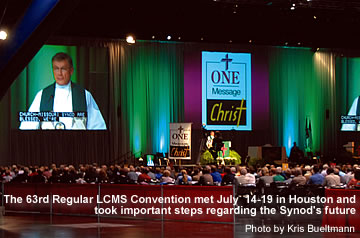
“One Message—Christ! His Love Is Here for You!”
This theme, the theme of the 63rd Regular Convention of The Lutheran Church—Missouri Synod, echoed daily through the halls of the cavernous George R. Brown Convention Center in Houston July 14–19.
The message echoed through the Texas-sized facility in the convention sermon of LCMS President Gerald B. Kieschnick, who was elected to a third consecutive term as the Synod’s chief executive. It echoed in the words of the convention’s Bible studies and devotions—and in the presentations of committee chairs and guest speakers. It echoed from the lips of delegates and guests who filled the convention center and its nearby hotels. And it echoed in the pre-convention outreach training at Immanuel Lutheran Church in Houston July 13: One message—Christ: His love is here for you—today!
By the numbers, the 2007 LCMS convention officially included 1,239 voting delegates—620 pastors and 619 laypeople—328 advisory delegates, 34 district presidents, three ad hoc committee members, two former officers, and 27 invited guests. Approximately 3,500 people attended the convention’s opening worship, and on a daily basis, others stopped in for a short visit or browsed the convention’s busy vendor displays.
A convention, however, is more than a collection of delegates selected to attend its sessions. It is also a living, breathing body that develops a life and personality of its own.
In many respects, the LCMS’ 63rd Regular Convention was among the most productive in recent years, and because of several resolutions it adopted, it may turn out to be a watershed moment for our 160-year-old church body.
At the conclusion of the convention, Kieschnick thanked the delegates and congratulated them on their work. He noted that he had attended every Synod convention since 1971, and in his opinion, the 2007 gathering demonstrated by far a greater sense of collegiality and harmony, combined with frank discussion of the issues, than any in his experience. He commended the delegates for the spirit of “trust and Christian respect that grew throughout the convention,” even at times when the issues were debated vigorously.
Synod secretary Raymond L. Hartwig echoed Kieschnick’s observations.
“Overall, the tone of the convention was positive, more positive than some other of our Synod’s conventions,” he said. “The delegates seemed to be well prepared, and there was good debate on most issues. While there were significant issues discussed, rarely were voices raised.”
Hartwig also noted that streaming the activities of the convention live on the Internet added a new dimension to convention coverage for LCMS members.
“The use of this opportunity increased as the convention proceeded,” Hartwig said. “It allowed the people of the Synod to observe firsthand the convention conducting its business. What an important learning opportunity for people who have never observed a convention of their Synod!”
Getting down to business
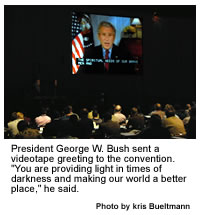 In its five days of morning and afternoon sessions (Thursday, the last day of the convention, was a morning session only), the convention considered nearly 100 resolutions, adopting all but a few. Of those resolutions, any list of the most significant would likely include resolutions to endorse the calling of a special convention in 2009, the declaration of altar and pulpit fellowship with The American Association of Lutheran Churches, and the endorsement of a Specific Ministry Pastor Program. Also at the top of such a list: resolutions to support the revitalization of 2,000 LCMS congregations by 2017 (see sidebar, p. 9), to state the position of the LCMS on stem-cell research, and to clarify the relationship between Synod’s Board of Directors and its Commission on Constitutional Matters.
In its five days of morning and afternoon sessions (Thursday, the last day of the convention, was a morning session only), the convention considered nearly 100 resolutions, adopting all but a few. Of those resolutions, any list of the most significant would likely include resolutions to endorse the calling of a special convention in 2009, the declaration of altar and pulpit fellowship with The American Association of Lutheran Churches, and the endorsement of a Specific Ministry Pastor Program. Also at the top of such a list: resolutions to support the revitalization of 2,000 LCMS congregations by 2017 (see sidebar, p. 9), to state the position of the LCMS on stem-cell research, and to clarify the relationship between Synod’s Board of Directors and its Commission on Constitutional Matters.
But first, elections …
A third term
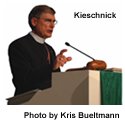 Nearly the first order of business for any convention is the election of the president of the Synod. On the opening day of the convention, Kieschnick was elected on the first ballot to a third term as the Synod’s chief officer, receiving 52.3 percent of the votes. On the slate with Kieschnick were Dr. William R. Diekelman, Rev. Daniel Preus, Rev. Wallace R. Schulz, and Rev. John W. Wohlrabe Jr.
Nearly the first order of business for any convention is the election of the president of the Synod. On the opening day of the convention, Kieschnick was elected on the first ballot to a third term as the Synod’s chief officer, receiving 52.3 percent of the votes. On the slate with Kieschnick were Dr. William R. Diekelman, Rev. Daniel Preus, Rev. Wallace R. Schulz, and Rev. John W. Wohlrabe Jr.
In subsequent elections, Diekelman was re-elected as first vice-president of the Synod. Dr. Paul Maier was elected second vice-president; Wohlrabe, third vice-president; and Dr. Dean Nadasdy and Dr. David Buegler fourth and fifth vice-presidents respectively.
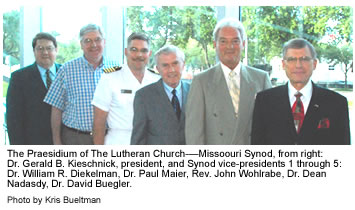
In other elections, Hartwig was reelected as the secretary of Synod and Thomas W. Kuchta as vice-president—finance/ treasurer.
In remarks after his election, Kieschnick called attention to the anniversary of the Reformation forthcoming in 2017.
“We look forward to the many opportunities that exist,” Kieschnick said, “especially in the next 10 years leading up to the 500th anniversary of the Reformation—opportunities for providing collective, courageous leadership in Lutheran churches around the world, and through our confessional witness to the entire Christian church on earth.”
In concluding his remarks, Kieschnick thanked the Council of Presidents, other officers of the Synod, and his family for their support.
A special convention
By a vote of 793–325, delegates on the last day of the convention authorized the Council of Presidents and the President of the Synod to call a special convention in 2009 if the council and the president determine that such a convention is necessary.
The special convention would have as its only task the consideration of Synod structure and governance.
According to the resolution, the president is directed to meet with the Council of Presidents within 90 days of the close of the 2007 convention, and after discussions with other Synod officials, the presidents of the Synod’s two seminaries, and the Commissions on Theology and Church Relations and Constitutional Matters, determine whether a special convention is required. A two-thirds vote of the Council of Presidents would be required to call the special convention.
Former Synod presidents Ralph Bohlmann and Robert Kuhn (who is also the chairman of Synod’s Board of Directors) endorsed the resolution, as did Thomas Kuchta, Synod vice-president—finance and Synod treasurer. All said that for the Synod to operate efficiently in the coming years, a more streamlined structure must be adopted.
In his address, Kuhn compared the Synod’s structure to an old house—charming and lovely and historic, indeed, but also in need of constant remodeling. “It’s time to build a new house,” he said.
Kuhn also told the delegates the Board of Directors felt it was “strategically important” to have a special convention.
The delegates were not persuaded easily. Vigorous discussion ensued over several sessions before a substitute resolution (8-07S) offered by Rev. Kenneth Roberts, a delegate from the Pacific Southwest District, addressed both delegate concerns and the desires of the committee proposing the resolution.
Citing delegate concerns, Dr. Larry A. Stoterau, Pacific Southwest District president and co-chair of the floor committee presenting the resolution, asked, on behalf of the committee, for “forgiveness” for some of the misunderstandings that had occurred during the discussion of the proposal. “In the spirit of working together” he moved that the substitute resolution require a two-thirds vote to adopt. (As a substitute resolution, the measure would have required only a majority vote.) The delegates agreed immediately, and after further debate, the resolution passed by the 70.9 percent margin noted above.
Following the adoption of the resolution, Kieschnick expressed his “deep appreciation” for the manner in which the delegates addressed the topic.
A new partner church
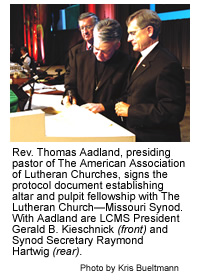 With the adoption of Res. 3-01 on Monday, July 16, the convention declared the LCMS in altar and pulpit fellowship with The American Association of Lutheran Churches (AALC). The AALC becomes the 30th Lutheran body with which the Synod has such fellowship—and the first North American body with which it has such an association.
With the adoption of Res. 3-01 on Monday, July 16, the convention declared the LCMS in altar and pulpit fellowship with The American Association of Lutheran Churches (AALC). The AALC becomes the 30th Lutheran body with which the Synod has such fellowship—and the first North American body with which it has such an association.
The national offices of the AALC are in Fort Wayne, Ind., and its seminary is currently housed on the grounds of Concordia Theological Seminary in Fort Wayne.
Established in 1987 by pastors and congregations concerned about the doctrinal positions of the church bodies involved in the merger negotiations that led to the formation of the Evangelical Lutheran Church in America in 1988, the AALC comprises 78 congregations and approximately 14,100 baptized members. It has slightly more than 100 pastors.
“By the action you have just taken, and by that taken by the AALC in convention last month, we have just declared fellowship with one another in those sacred gifts given by our Lord Himself to us, which He bestows upon us through His holy Word and Sacrament,” said Rev. Thomas Aadland, AALC presiding pastor. “This is truly an awesome thing—that the unity we have in Christ has now been so expressed because of mutually recognized concord in faith and life.”
The declaration of altar and pulpit fellowship recognizes agreement in doctrine and practice between the LCMS and the AALC and permits the members of each to commune at each other’s altars, and for LCMS and AALC pastors to exchange pulpits.
Specific ministry pastors
To meet the urgent mission needs of the LCMS, the delegates to the convention approved a resolution (5-01B) to establish a new ministry track to prepare men for ordination.
The “Specific Ministry Pastor Program” prepares pastors for specific ministries such as outreach to immigrant communities or service in specific mission fields. The program employs distance education, pastor mentoring, and on-campus seminary instruction—before and after ordination—to train candidates accepted into the program. Although they will proceed at their own pace, candidates may qualify for ordination as a “Specific Ministry Pastor” in about two years, explained Dr. Jon Diefenthaler, chairman of the convention’s Floor Committee for Seminary and University Education, which presented the resolution for adoption.
The new program has the support of the Synod’s two seminaries.
District presidents will nominate students for the program. Students will also go through the same admissions process as traditional seminary students, but they will continue serving their “home” ministries while they study.
Dr. Andrew Bartelt, Concordia Seminary vice-president for academic affairs, said the new program marks a “significant change” for pastoral ministry by taking advantage of modern technology and distance-education models. He told delegates it resolves the need for pastors in “a positive, constructive, and theologically responsible way.”
The program’s goal is a good one—“more pastors,” Bartelt said. “Good pastors who are about seeking and saving the lost and nurturing them in the faith until Christ comes again.”
Dr. Lawrence Rast, Concordia Theological Seminary academic dean, assured the delegates that specific ministry pastors “will be well-instructed in our confessional theology” and under the supervision of the seminary faculties. He said the new program fits his seminary’s commitment to prepare pastors in both traditional and nontraditional ways.
Once ordained, a Specific Ministry Pastor will be able to conduct a Word and Sacrament ministry only in the circumstances to which he has been called. He will be supervised by fellow pastors and his district president.
LCMS missionary Tim Nickel, who serves in Kyrgyzstan, called the program a “wise and creative solution” to the Synod’s shortage of pastors, especially in mission fields such as his, where the number of congregations planted far outstrips the number of pastors available to serve them.
Over the next few years, the Specific Ministry Pastor Program will replace DELTO (Distance Education Leading to Ordina-tion), the current nontraditional pastoral-education program. Unlike DELTO, the Specific Ministry Pastor Program will offer students the opportunity to con-tinue their studies and earn a master of divinity degree at Concordia Seminary or Concordia Theological Seminary.
Addressing issues and opportunities
Not only did the delegates adopt the resolutions just mentioned, they also adopted a host of resolutions concerning a variety of issues and opportunities, including the following:
Missions. Delegates approved resolutions to prepare a new study on the priesthood of all believers and to report detailed accounting of Fan into Flame funds. They also approved resolutions to commend the LWML, Lutheran Hour Ministries, and LCMS chaplains.
District and Congregational Services. The convention approved several resolutions dealing with worship: To foster greater understanding of worship through theological conferences, to provide guidance and direction for use of contemporary worship resources, and to commend the Commission on Worship for the Lutheran Service Book. The delegates also endorsed resolutions to encourage individual confession and absolution, to celebrate the anniversaries of several Synod founders, and to initiate planning for the 500th anniversary of the Reformation.
Theology and Church Relations. In addition to declaring altar and pulpit fellowship with the AALC, the delegates directed the CTCR to develop a plan for confessional leadership and to address environmental issues. Delegates also encouraged congregations that allow open Communion to “return to faithful Communion practices by practicing close(d) Communion.” They called for a study of the natural knowledge of God, and requested further guidance for civic events that include serial prayers.
Program and Finance. Stating that division diverts energies from mission, convention delegates directed the Council of Presidents and the Board of Directors to address mistrust in the Synod and to shape a strategy to restore harmony. The delegates also adopted a resolution to encourage stewardship renewal and requested the Council of Presidents to develop a mentoring and training program for clergy with an emphasis on biblical whole-life stewardship, to be presented to the 2010 convention. The convention also commended the LCMS Foundation for its 50 years of service, encouraged support for the Center for Hispanic Studies at Concordia Seminary, and voted to hold the 2010 LCMS convention in Houston.
Seminary and University Education. In addition to establishing the Specific Ministry Pastor Program, the convention directed the Board for Pastoral Education and the Council of Presidents to “study the situations currently served by licensed lay deacons to determine whether there continues to be a genuine need for the program within the Synod.” The delegates directed the two entities to prepare a report on the issue for the 2010 convention. Delegates also voted to strengthen the boards of regents of the Synod’s two seminaries and the schools of the Concordia University System. They also approved a resolution encouraging pastors to develop a plan for continuing theological education. The resolution further encourages congregations to aid pastors in this effort by granting study leaves and financial aid to help cover the cost of the education.
Human Care. In addition to urging the Synod and its members to give public witness to the LCMS position on stem-cell research, convention delegates adopted resolutions to give thanks for disaster relief and support, to develop abuse-education materials and programs, and to encourage the church to include people with disabilities in all aspects of its life.
Delegates also adopted a resolution that calls on LCMS World Relief and Human Care to conduct ongoing conversations with LCMS Recognized Service Organizations that place adopted or foster children so they do not “knowingly place adopted or foster children into any intrinsically sinful situation where individuals and families are not living in accordance with the Lord’s revealed and natural law.”
Planning and Administration. In introducing the work of his floor committee to the convention, Indiana District president Dan May noted that “the interesting work of Committee 7 is interesting only to a few because it deals with a lot of minutiae and detail.”
Nevertheless, delegates followed the work of the committee closely, adopting a resolution to promote “transparency” in the governance of the Synod and its institutions, amending a bylaw concerning emeritus—retired—members of the Synod and another dealing with the Synod’s doctrinal-review process.
The principal function of the resolution calling for transparency will be to direct agencies of the Synod to announce upcoming meetings and, upon request, to make available the minutes of Synod board and commission meetings.
Synod Structure and Governance. In addition to authorizing the President of the Synod and the Council of Presidents to consider a special convention, delegates also adopted carefully worded amendments to Synod’s Articles of Incorporation and Bylaws. The aim is to clarify authority between the Synod’s Board of Directors and the Commission on Constitutional Matters. The delegates also affirmed the Synod’s dispute-resolution process, recommended the study of CTCR documents relating to public rebuke of public sin, and encouraged congregations to “include the words inspired, inerrant, infallible and/or revealed in their constitutions and/or bylaws.”
Assessment and impressions
In reviewing the work of the convention, Synod secretary Raymond Hartwig observed that the convention addressed some significant issues.
“I personally believe that Res. 8-01 [clarifying the relationship of the Board of Directors and the Commission on Constitutional Matters], building upon Res. 7-02A of the 2004 convention, has given our Synod the opportunity to move forward now and leave behind some of the authority issues that have troubled us,” Hartwig said. “And certainly the Specific Ministry Pastor issue will have great consequence for our Synod. But the strong manner in which our convention addressed inspiration of Scripture and sanctity of life issues made me especially proud to be a member of this Synod. It is an amazing and beautiful thing how we are able to stand up and stand together on these most significant issues.”
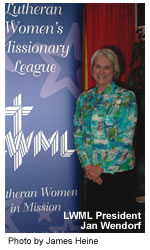 For newly elected LWML president Jan Wendorf, who brought greetings to the convention, the Synod assembly is very different from a convention of the LWML.
For newly elected LWML president Jan Wendorf, who brought greetings to the convention, the Synod assembly is very different from a convention of the LWML.
“We’re not charged with doing the business of The Lutheran Church—Missouri Synod,” Wendorf said. “We’re an auxiliary with a very specific focus. Here there are seven or eight, or more, floor committees dealing with issues that are really important to our church body. It’s interesting to see the process. I have such an admiration for our leaders—our president, our vice-presidents, our district presidents, and our seminaries. It’s just amazing to see how they can work together and get things accomplished—and hopefully get our church healed and focused on that one mission of Christ.”
In the eyes of Southern Illinois District president Herbert Mueller, the 2007 convention was a step forward from 2004. In 2004, Mueller said he went home from the convention with “a sense of profound frustration.”
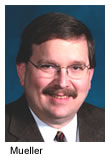 “I’m going home from this convention calm and collected,” Mueller said. “I’m not happy about everything, but I’m happy about most things.”
“I’m going home from this convention calm and collected,” Mueller said. “I’m not happy about everything, but I’m happy about most things.”
Mueller said he was particularly pleased with several resolutions, including the resolution establishing the Specific Ministry Pastor Program. “That’s something a lot of people have been talking about and working toward,” Mueller said, “and I pray that it’s something that’s going to help our Synod address the need for pastors, especially in specialized situations, in a way that is faithful to our Confession and faithful to the Bible.”
Mueller said he was also pleased with the prayer service at the beginning of the convention. It helped set the tone for the convention, he said.
“It was a tool used by God to help mold the delegates so that there was a higher level of churchmanship and a greater sense of cordiality than at previous conventions.”
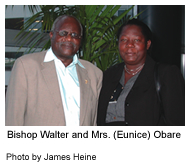 For Rev. Walter Obare, bishop of the Evangelical Lutheran Church in Kenya, a partner church of the LCMS, the way the convention conducted its business merited notice.
For Rev. Walter Obare, bishop of the Evangelical Lutheran Church in Kenya, a partner church of the LCMS, the way the convention conducted its business merited notice.
“It is peaceful, and it is well prepared,” he said near the end of the convention. “And I am happy that as much as they continue to discuss so many other things, they try again and again to come back to the focal point of what makes the church be the church—the Gospel. And with that I’m impressed.” And so, at the end, the message is the same as at the beginning: Christ! His love is here for you—today!
For more information
A few thousand words do scant justice to the work of the 2007 LCMS convention. For more information, visit lcms.org and click on one of the convention links, or on the link for Reporter Online, which offers a more detailed look at the convention.
Reflecting on Two Decades of Service
Among the many events noted by the convention, the retirement of Dr. Robert H. King from the Praesidium of the Synod merits a special word.
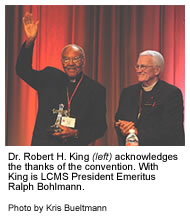 King, 85, served 21 years as a vice-president of Synod. Ordained in 1949, King calls his long tenure as a vice-president “the Lord’s doing—otherwise I would have never served 21 years.
King, 85, served 21 years as a vice-president of Synod. Ordained in 1949, King calls his long tenure as a vice-president “the Lord’s doing—otherwise I would have never served 21 years.
“I feel that the Lord was using me for some special purpose,” King adds, “I don’t know what, but I certainly give Him all the honor and glory.”
King said he has worked with four LCMS presidents—Bohlmann, Barry, Kuhn, and Kieschnick—and he describes all of them as outstanding leaders in the church. “Even though some people may have their criticisms, I know that they wouldn’t have been in those offices had not the Lord called them,” King said.
For his long service to the church, Synod president Gerald B. Kieschnick presented King with a Waterford crystal cross that rests on a marble base.





